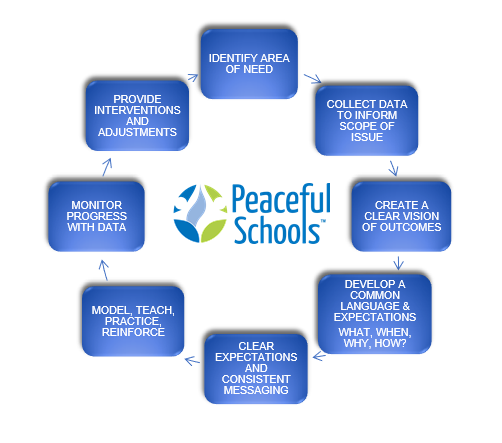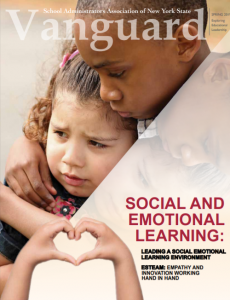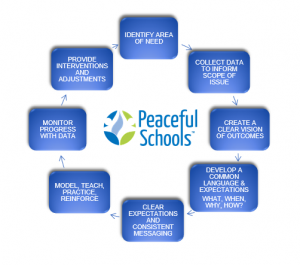What is Missing From Our Social Emotional Learning Plan? Systems Thinking!


Educators spend a substantial amount of time trying to solve problems, and even more time wondering why our solutions did not yield the expected results. When it comes to implementing social and emotional learning, if we expect to have an impact, we must apply systems thinking to our plan. Carin Reeve, Director of School Improvement, wrote recently in Vanguard Magazine about the importance of a systems thinking approach to supporting the social and emotional health of our students.
What is Missing From Our Social Emotional Learning Plan? Systems Thinking!
In the past two decades, schools have become increasingly aware of the need to support students’ social and emotional development. There are programs to purchase, videos to watch, songs to sing, and character traits to read about, but concerns about classroom behavior and children lacking problem solving skills are prevalent. For school leaders and classroom teachers, the need to support both social and emotional learning and high academic standards is real—but how to do both, and do them both well, is a continual challenge.
A strong foundation in social and emotional learning does more than just make a difference in academic growth and achievement; it actually gives children the kind of skills they will need to be successful in school and in life. Research supports that “effective mastery of social-emotional competencies is associated with greater well-being and better school performance whereas the failure to achieve competence in these areas can lead to a variety of personal, social, and academic difficulties” (Durlak, et al, 2011).
Building a school culture, deeply rooted in social and emotional skills requires leadership with a clear vision, a systems-based approach, and regular opportunities for practice and feedback.
Why do we need a foundation in Social and Emotional Learning?
The process of education has changed very little in the past decades, however, the expected outcomes for education have changed dramatically. In a recently published white paper, the Organisation for Economic Cooperation and Development (OECD) looked to the year 2030, when children who started school in 2018 will be graduating, to make policy and practice recommendations for the way we educate around the globe. OECD identified that today’s children will inherit unprecedented environmental, economic, and social concerns as adults (OECD, 2018.). Tomorrow’s adults will need to think, learn, and work differently in order to solve these complex and interconnected problems. We can no longer prepare children to inherit these future problems with the instructional practices of the past.
Today’s children are more connected through technology, yet, they are less connected in terms of social, interpersonal, and collaborative skills. Developing the nuances of communication, empathy, or active listening is nearly impossible through text or other forms of online communication (http://newyorkbehavioralhealth.com/the-impact-of-social-media-use-on-social-skills). Additionally, today’s children are bearing the weight of trauma, neglect, violence, and abuse at alarming rates: according to www.recognizetrauma.com, 26% of children have experienced significant trauma before the age of four and 60% of today’s adults have experienced a trauma during their formative years (http://www.recognizetrauma.org/statistics.php).
The evidence clearly supports the extent of the need for social and emotional learning. So, what do schools need to do to ensure that today’s children get the skills that they will need to succeed in tomorrow’s world?
Building a strong foundation in social and emotional skills requires systems
When there is something as critical as our children’s’ future at stake, the phrase “hope is not a strategy” (Page, 2003) takes on new meaning. Ensuring that students have the social and emotional skills that they will need requires a systems thinking approach.
Systems are the interconnected structures that allow for ongoing growth and discovery. Systems thinking is proactive: looking at a problem from impact to outcome in order to build a connected, planned, and thorough response that is clear to all stakeholders. Systems thinking uses progress monitoring and feedback to make adjustments that will ensure better outcomes. In this way, systems can learn to become more efficient and effective.
1. Identify the need based on data. Finding the right solution requires data to identify the actual problem. Without informing our understanding with data, we run the risk of responding to our own perception of the problem. Data provides the who, what, when, where, and how this problem is playing out.
2. Create a clear vision. A systems thinking approach to social and emotional learning needs a clear vision of the expected outcomes. Too often in schools, we spend our time and our resources implementing programs that we have not really planned for, and it is that lack of planning that leads to failed implementation. In our work with schools, we regularly hear feedback about how much time and effort was spent in bringing in a program or an assembly, and then a few weeks later the school staff is noticing that everyone is back to their old patterns of behavior. Having a clear vision requires that everything connects to that vision and supports the expected outcomes.
3. Develop a common language and message it consistently. One of the key steps in planning lies in developing common language for expectations and messaging those expectations. When we articulate a vision for social and emotional learning, we take the time to identify what it will look like, feel like, and sound like in our school for students and adults. Common expectations should be evident throughout the school in what students and adults say and do. Clear, consistent expectations must be owned by everyone or they will not become a cultural norm.
4. Model, teach, practice, and reinforce. Building any new skill set takes practice; for adults and students. Opportunities to practice must be provided regularly if we expect skills to be applied to more complex situations as children develop. School-wide systems must build in opportunities to model, teach, practice, and reinforce in more complex situations if these new skills are going to become fully embedded in the culture of the school. Any time we hear ourselves say, “Our kids can’t…,” we must remind ourselves that it is an opportunity to model, teach, practice, and reinforce new skills.
5. Monitor progress and provide intervention. Systems allow schools to move along a continuum of implementation—moving forward or backward based on the needs of the building, the classroom, or the individual student. Monitoring the progress of implementation with data helps to identify areas for potential intervention or adjustment of the plan. This progress monitoring will inform the effectiveness of the system already in place and identify gaps that must be filled. This is not a failure; rather it is an opportunity for additional growth!
In conclusion
When we begin to think about systems for social and emotional learning in schools, we need to understand why we are addressing this need. Today’s children are coming to school with greater needs for social and emotional support and lagging skills in communication, emotional regulation, and executive functioning. As a result, schools must embrace their role in helping children develop and master social and emotional skills so that they can successfully navigate the complexities they will face in the future.
Building systems to support social and emotional learning in schools is different from implementing a program or doing an activity because it is a proactive plan that is developed in response to identified needs. Over time, these systems can change the culture of a school as the common language becomes the norm for all adults and children. Systems allow opportunities for skills to be modeled, explicitly taught, practiced, and reinforced, and additional data informs the skills that need additional support or intervention.
When we consider the responsibility that we have as educators to prepare today’s children for the future that they will inherit, we know that we must provide children with the opportunities that they need to master social and emotional skills within the context of collaboration, independence, and caring relationships. Schools leaders who can see the opportunity for children to grow and develop these skills throughout the continuum of K-12 education, must create systems that can learn, grow, and be responsive to the needs of the children and adults that they serve. There is no time to wait. It’s time to lead the change we know is needed.
Resources
Durlak, Joseph, et al. 2011. The Impact of Enhancing Students’ Social and Emotional Learning:A Meta-Analysis of School-Based Universal Interventions. Retrieved from http://www.episcenter.psu.edu/sites/default/files/news/Durlak%20et%20al.%20(2011)%20meta%20analysis%20SEL.pdf
The impact of social media use on social skills. (Web blog post). Retrieved from http://newyorkbehavioralhealth.com/the-impact-of-social-media-use-on-social-skills
Organisation of Economic Cooperation and Development. 2018. The future of education and skills: Education 2030. Retrieved from www.oecd.org
Page, Rick. 2003. Hope is not a strategy. New York: McGraw-Hill.
Recognize trauma: Statistics. (Web post). Retrieved from http://www.recognizetrauma.org/statistics.php




